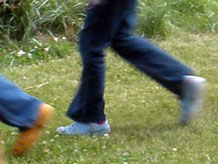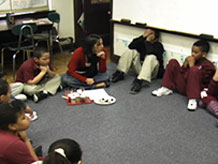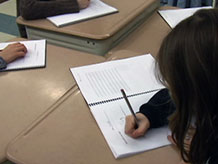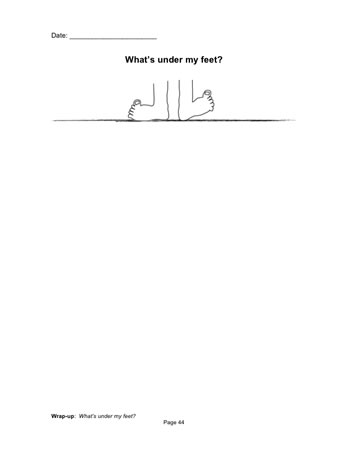What's under my feet?
Plan Investigation 5.3

The students have spent several weeks looking closely at small samples of earth materials and carefully measuring weights and volumes. It's time for them step back out into the natural world — at least in their imaginations.
Students imagine standing in a place somewhere on Earth’s surface. They identify two earth materials that might be under their feet and use their experiences in this curriculum to think about their properties including "heavy for size" and imagine possible transformations that might have occurred.
By the end of the investigation students will have made connections between their classroom work with earth materials and what's actually underfoot when they stand in different places on Earth's surface.
Learning Goals
- Think about earth materials in the real world
| Sequence of experiences | ||
|---|---|---|
| 1. Ask the question | All Class | 5 Mins |
| 2. Prepare to discuss | All Class | 20 Mins |
| 3. Where are we now??? | Discussion | 20 Mins |
Materials and Preparation

- Post the investigation question in a place where all students can see it.
- Post the class chart of earth materials that was created in the first class.
- 1 set of earth materials: pebbles, gravel, sand, clay, organic soil, shells, water, mineral oil, rocks, and minerals (for the demonstration)
Notebook Pages
1. Ask the question

Start by reminding the class where they began the unit. Remember how, in the first class, we closed our eyes and imagined standing barefoot someplace on Earth's surface? Someplace that wasn't covered by a carpet or a floor or a parking lot or a sidewalk?
- We're going to do that again today only we'll be discussing a new set of questions.
Draw attention to the investigation question:
What's under my feet?
2. Prepare to discuss

Ask students to think of a place where they could stand in their bare feet on Earth's natural surface and to name two earth materials that might be under their feet.
Provide time for them to think of a place and the earth materials.
Direct them to the last notebook page where they will find a few questions that will be the focus of their wrap-up discussion. [What's under my feet?].
Provide time for them to draw their place and to jot down responses to the questions. After they have had time for notebook writing, ask students to turn and talk to a neighbor about their place and their ideas.
Location, Location, Location: Just as Earth's surface has a great variety of conditions, the earth materials under our feet will vary with location. In fact, no two shovelfuls of soil will ever be identical — even if both are sand from adjacent locations. While it's possible that a soil sample would include the full variety of mineral sizes (pebbles, gravel, sand, silt, and clay), as well as some organic matter, these materials would not occur in exactly the same proportions.
3. What are our ideas now?
Purpose of the discussion
The purpose of the discussion is to consolidate learning from across the unit and for students to connect their learning to a self-selected location. This is also an opportunity to elicit students' ideas about the concepts central to this study (e.g., properties of earth materials, heavy for size, volume, weight, transformations.) Focus the discussion on the following questions:
What are two earth materials under your feet? How might they have been transformed?
Engage students in discussion
Students will have started the conversation with a partner already. Now they will broaden the conversation with all of their classmates.
In order to make this a real discussion rather than a “report out,“ encourage students to build on each others' comments by, for example, adding on, comparing and contrasting, asking questions, challenging respectfully.
1) Begin with a discussion of properties of earth materials.
What place did you select? What are two earth materials that might be under your feet?
Supporting questions:
- Did anyone else select a (beach, playground, field, etc.)?
- People who chose a beach, did you pick the same earth materials or different ones?
- What about a different place? How do you think the weights of two same-sized samples would compare? Are there other ideas about volumes and weights?
2) Consider possible transformations that might have taken place.
How do you think the materials under your feet might have been transformed?
Supporting question:
- What are your ideas about weight and volume in this transformation process?
Summarize the discussion
Summarize some of the ideas you heard, pointing out evidence that students' ideas about earth materials have broadened and matured over the course of this science unit.
Learning always ends with new questions. End with an opportunity to raise questions.
- What other things would you like to know about earth materials? How could you find out about them?





